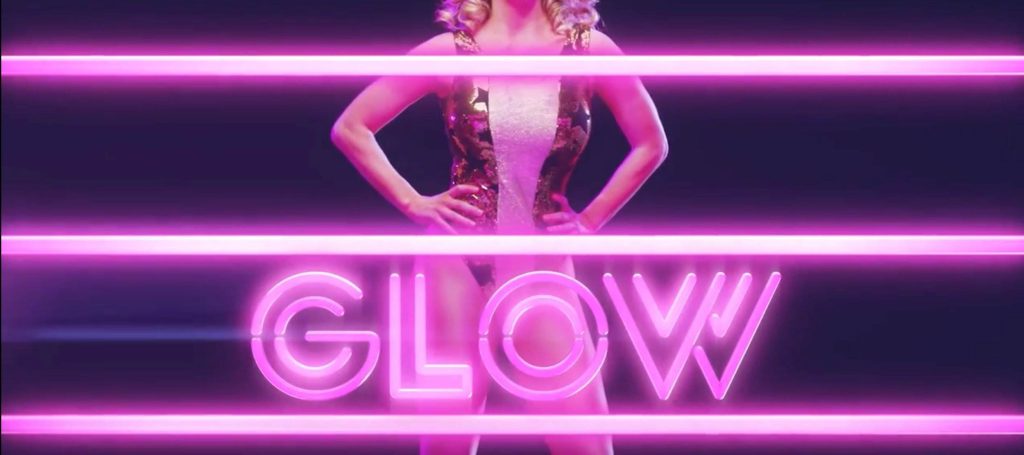What is GLOW?
GLOW is an upcoming Netflix original series about GLOW premiering on Friday, June 23.

So what is GLOW?
GLOW, or Gorgeous Ladies of Wrestling, was a televised women’s wrestling promotion that premiered in 1986. Despite the fact that some people (me) think that wrestling is utterly captivating as both a sincere form of low-brow entertainment and fascinating post-modern expression (it is), it can seem alienating or uninteresting to dive into a TV dramatization of one of the most overly dramatic entertainment mediums from the mid-80’s. If the trailer is an accurate portrayal, GLOW is a show that lives by its character work. To help with the rest, here are 10 Things You Should Know About GLOW.
1. The First Televised Women’s Promotion
While the late 70’s through the early 90’s were arguably the second best time for women’s wrestling not counting the past year or so, it didn’t have a TV presence, and the various successful women’s wrestling company’s of that time period didn’t have the television exposure. GLOW was the first televised women’s wrestling program, and as such the women on the match cards would have matches that were just as long as matches by male performers in other promotions, a far cry from the doldrums of 2-minute evening gown pool matches that followed in the WWE just a decade later.
2. Trained by a Guererro

The head trainer of GLOW was Mando Guerrero. Does that name sound familiar? It should. Mando is from the Los Guerreros wrestling dynasty and older brother of Eddie Guerrero, one of the most beloved and respected wrestling talents of all time. If you have a promotion full of wrestling blank slates as Gorgeous Ladies of Wrestling did, you can’t do better than having a Guerrero as a teacher.
3. Sir Miles Headlock
GLOW was never really concerned with realism in its storytelling or presentation. This was perhaps at its zenith with commentator Miles Headlock (a play on Max Headroom). Sir Miles Headlock was played by Douglas Dunning and billed himself as the first computerized commentator in history. While Headlock was certainly unsettling, the most impressive part of Dunning’s performance is that it somehow fails to shatter the suspension of disbelief.
4. That’s A Rap
It’ll be interesting to see how the upcoming show chooses to handle one of the most easily identifiable aspects of its source material; one which is at once hilariously endearing and cringe-inducing. Each of the performers had to perform a rap to the same backing beat. The results are… well… just watch.
5. Fiction or Fictionalized?

Alison Brie’s character, Ruth Wilder, is an out of work actress who happens upon GLOW. While this seems believable and is close to the truth of several of the women involved in the promotion, Ruth Wilder never existed. In fact, every character is not just a fictionalization, but completely fictional. In a way, this frees the writers to explore the story in any way they see fit. On the other hand, fans of the original program may be surprised to see that characters they remember fondly are being presented in a very copyright-friendly way.
6. Kayfabe Is For Lovers
Okay, so kayfabe. Let me give you a quick ELI5. Kayfabe is the fiction that a wrestling promotion and the wrestlers present as the truth. Stone Cold Steve Austin assaulted his boss in kayfabe. CM Punk lost his UFC debut in real life. Does that make sense? Good! In the 80’s, kayfabe was in a much different place than it is in an age of Twitter. It wasn’t uncommon for wrestlers to fear for their life leaving a venue if they played the heel (bad guy) in an angle (storyline). As mentioned, GLOW never had the most serious fiction and was more than a little absurd. Like, did anyone thing Matilda the Hun was an actual Hun? Well, the performers had to stay in character 24/7. Faces (good guys) and heels (you should know this one) weren’t allowed to associate in public and breaking kayfabe would result in a $50 fine.
7. Novelty
Women’s wrestling was popular before GLOW, but not really. When one of the larger American wrestling companies would put on a show that featured a women’s match on the card, it often sold tickets but as a novelty. Women’s wrestling had a very carny-sideshow feel to it. While several women’s wrestling promotions existed to dispel this perception, none had the wide reach that GLOW had.
8. A Stallone Was Involved
Do you want to know who we can thank for GLOW? Sylvester Stallone’s mother. GLOW grew from Jaqueline Stallone’s women’s fitness gym, with Momma Rocky herself serving on the production team. Not content with a behind-the-camera only position, Stallone would go on to serve as the on-screen manager for the stable of the Good Girls.
9. Season’s Greetings
It operated on a season by season basis, making it more like Lucha Underground than WWE. This allowed for an ever-evolving cast and the opportunity for more arc-based storytelling. It also meant that premiers and finales were going to feel more like substantial events than just another night of weekly wrestling.
10. Watch The Pilot
The pilot is the most 80’s thing you have ever seen. I know we throw that sort of thing around a lot, but it really is. I honestly don’t know what to write about this to accurately convey the glory of the thing. Watch it, won’t you?




